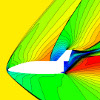Scientific Computing and Numerics (SCAN) Seminar
Radio-frequency engineering was sufficiently sophisticated by the 1960s to allow the construction of what were and still are the world's largest radars (the Arecibo Observatory in Puerto Rico and the Jicamarca Radio Observatory near Lima, Peru). These and other radars like them are used for observing state parameters in the ionosphere along with plasma turbulence that arises during space weather events. A complete theory for interpreting the ionospheric backscatter was unavailable until fairly recently, however. Moreover, spatio-temporal ambiguity inherent in the radar data is only now being resolved using a range of computational algorithms rooted in statistical inverse theory. In this talk, some of the algorithms will be reviewed, and a numerical simulation capable of predicting plasma convective ionospheric storms seen by the radars will be discussed.
